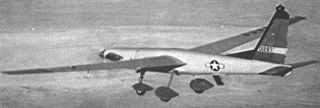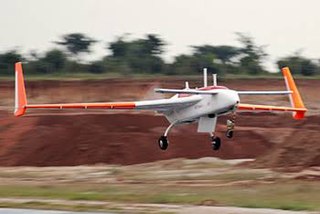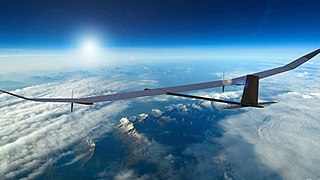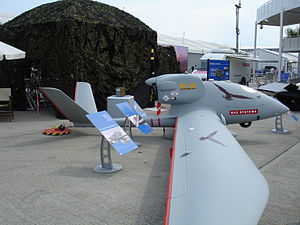
The AAI RQ-7 Shadow is an American unmanned aerial vehicle (UAV) used by the United States Army, Australian Army, Swedish Army, Turkish Air Force and Italian Army for reconnaissance, surveillance, target acquisition and battle damage assessment. Launched from a trailer-mounted pneumatic catapult, it is recovered with the aid of arresting gear similar to jets on an aircraft carrier. Its gimbal-mounted, digitally stabilized, liquid nitrogen-cooled electro-optical/infrared (EO/IR) camera relays video in real time via a C-band line-of-sight data link to the ground control station (GCS).

The Sikorsky Cypher and Cypher II are types of unmanned aerial vehicles developed by Sikorsky Aircraft. They are vertical takeoff and landing aircraft which use two opposing rotors enclosed in a circular shroud for propulsion.

The Bell Helicopter Eagle Eye, Model 918, was an American tiltrotor unmanned aerial vehicle that was offered as one of the competitors in the United States Navy's VT-UAV program.

The ADM-160 MALD is a decoy missile developed by the United States.

A miniature UAV, small UAV (SUAV), or drone is an unmanned aerial vehicle small enough to be man-portable. Smallest UAVs are called micro air vehicle.

The Boeing A160 Hummingbird is an unmanned aerial vehicle (UAV) helicopter. Its design incorporates many new technologies never before used in helicopters, allowing for greater endurance and altitude than any helicopter currently in operation.

The BAI Aerosystems (BAIA) BQM-147 Dragon unmanned aerial vehicle is a tactical battlefield UAV operated by the US Marine Corps.
The BAE Systems Taranis is a British demonstrator programme for unmanned combat aerial vehicle (UCAV) technology, under development primarily by the defence contractor BAE Systems Military Air & Information. The aircraft, which is named after the Celtic god of thunder Taranis, first flew in 2013. An unmanned warplane, the Taranis is designed to fly intercontinental missions, and would carry a variety of weapons, enabling it to attack both aerial and ground targets. It uses stealth technology, giving it a low radar profile, and is controllable via satellite link from anywhere on Earth.

The BAE Systems Phoenix was an all-weather, day or night, real-time surveillance Unmanned Air Vehicle. It had a twin-boom UAV with a surveillance pod, from which the imagery was data linked to a ground control station (GCS) that also controlled the aircraft in flight. It was the third generation of UAV in British Army service with the Royal Artillery after SD/1 and Canadair Midge.

The Ling-Temco-Vought XQM-93 was a remotely piloted aircraft developed in the United States in the late 1960s and early 1970s for use as a communications relay in the Vietnam War. A prototype flew in 1970, but the program was abandoned without producing a service-ready aircraft.

The BAE Systems Mantis Unmanned Autonomous System Advanced Concept Technology Demonstrator is a British demonstrator programme for Unmanned Combat Air Vehicle (UCAV) technology. The Mantis is a twin-engine, turboprop-powered UCAV with a wingspan of approximately 22 m, broadly comparable to the MQ-9 Reaper. Other partners involved in Phase 1 of the Mantis programme include the Ministry of Defence, Rolls-Royce, QinetiQ, GE Aviation, L-3 Wescam, Meggitt and Lola.
The BAE Systems Ampersand unmanned autonomous system (UAS) is an unmanned autogyro technology demonstrator, first announced at the 2008 Farnborough International Air Show. The Ampersand is based on the RotorSport UK MT-03 autogyro, with a sensor suite derived from the BAE Herti UAV. It is capable of being flown manned, for flight test purposes.

The DRDO Rustom is a Medium Altitude Long Endurance unmanned air vehicle (UAV) being developed by Defence Research and Development Organisation for the three services, Indian Army, Indian Navy and the Indian Air Force of the Indian Armed Forces. Rustom is derived from the NAL's LCRA developed by a team under the leadership of late Prof Rustom Damania in the 1980s. The UAV will have structural changes and a new engine. Rustom will replace/supplement the Heron UAVs in service with the Indian armed forces.

Atmospheric satellite or pseudo-satellite is a marketing term for an aircraft that operates in the atmosphere at high altitudes for extended periods of time, in order to provide services conventionally provided by an artificial satellite orbiting in space.
The Boeing Phantom Eye was a high altitude, long endurance (HALE) liquid hydrogen-powered unmanned aerial vehicle developed by Boeing Phantom Works. The aircraft was Boeing's proposal to meet the demand from the US military for unmanned drones designed to provide advanced intelligence and reconnaissance work, driven by the combat conditions in Afghanistan in particular. In August 2016, the Phantom Eye demonstrator was disassembled for display at the Air Force Flight Test Museum.
The Orion is a Medium-altitude long-endurance unmanned aerial vehicle (UAV) developed by Aurora Flight Sciences.

The Wind Shadow and Cloud Shadow, also known as Wing Loong-10, is a series of unmanned aerial vehicles of the High-Altitude Long Endurance (HALE) type, featuring a stealthy air-frame. As of 2017 it is being developed by the Chengdu Aircraft Industry Group for reconnaissance and precision strike missions.

The TAI Aksungur is an unmanned aerial vehicle (UAV) built by Turkish Aerospace Industries (TAI) for the Turkish Armed Forces. Using existing technology from the TAI Anka series of drones, it is the manufacturer's largest drone with payload capacity for mission-specific equipment. It is intended to be used for long-term surveillance, signals intelligence, maritime patrol missions, or as an unmanned combat aerial vehicle. TAI planned to integrate weapon packages and put the Aksungur into production in early 2020. The first unit was delivered to the Turkish Naval Forces on 20 October 2021.

The BAE Systems Persistent High Altitude Solar Aircraft (PHASA-35) is a High-Altitude Long Endurance (HALE) unmanned aerial vehicle (UAV) developed by BAE Systems in collaboration with Prismatic. Designed as a cheaper alternative to satellites, the aircraft can be used for surveillance, border control, communications and disaster relief with a potential ability to stay airborne for up to 12 months. Developed in less than two years, the aircraft carried out its first flight in February 2020 and further trials are currently ongoing.

An unmanned surveillance and reconnaissance aerial vehicle, is an unarmed military UAV that is used for intelligence, surveillance, target acquisition, and reconnaissance (ISTAR). Unlike unmanned combat aerial vehicle (UCAV), this type of system is not designed to carry aircraft ordnance such as missiles, ATGMs, or bombs for drone strikes. The main purpose is to provide battlefield intelligence. Small sized short-range man-portable unmanned aerial vehicles are called Miniature UAV also used for battlefield intelligence.

















